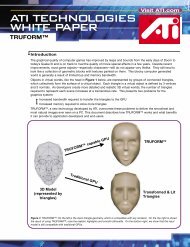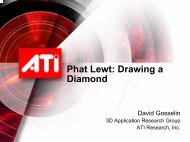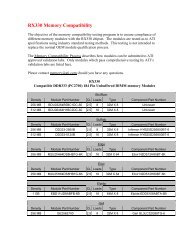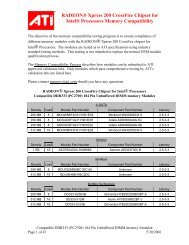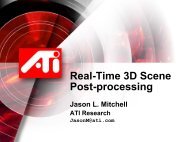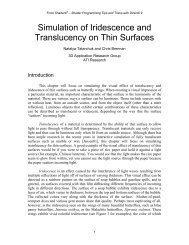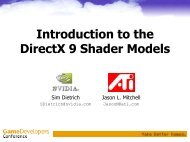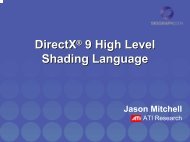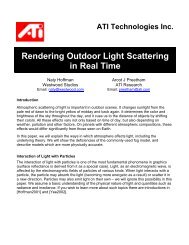Direct3D HLSL Programming using RenderMonkey IDE
Direct3D HLSL Programming using RenderMonkey IDE
Direct3D HLSL Programming using RenderMonkey IDE
Create successful ePaper yourself
Turn your PDF publications into a flip-book with our unique Google optimized e-Paper software.
Translucent Iridescent<br />
Shader: Vertex Shader<br />
..<br />
// Propagate input texture coordinates:<br />
Out.Tex = Tex;<br />
// Define tangent space matrix:<br />
float3x3 mTangentSpace;<br />
mTangentSpace[0] = Tangent;<br />
mTangentSpace[1] = Binormal;<br />
mTangentSpace[2] = Normal;<br />
// Compute the light vector (object space):<br />
float3 vLight = normalize( mul( inv_view_matrix, lightPos ) - Pos );<br />
// Output light vector in tangent space:<br />
Out.Light = mul( mTangentSpace, vLight );<br />
// Compute the view vector (object space):<br />
float3 vView = normalize( mul( inv_view_matrix, float4(0,0,0,1)) - Pos );<br />
// Output view vector in tangent space:<br />
Out.View = mul( mTangentSpace, vView );<br />
// Compute the half angle vector (in tangent space):<br />
Out.Half = mul( mTangentSpace, normalize( vView + vLight ) );<br />
return Out;<br />
Compute Halfway vector<br />
Compute Define H tangent light = V vector + L space in matrix<br />
Compute<br />
tangent<br />
view<br />
space<br />
vector<br />
in tangent space<br />
in tangent space<br />
Game Developer Conference, San Jose, CA, March 7 th 2003



